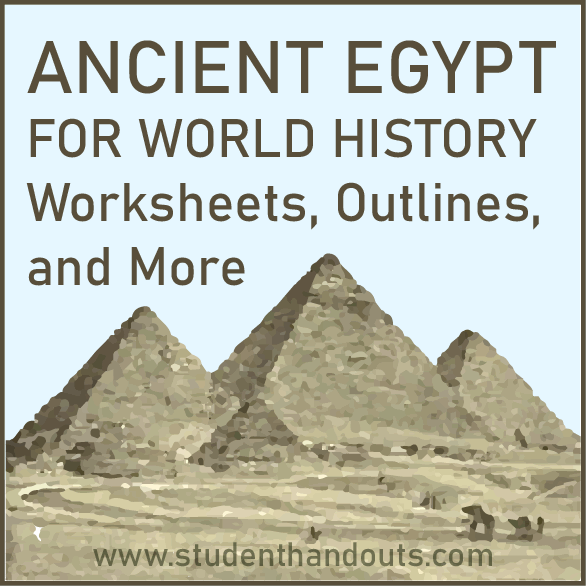 |
Ancient Egypt Educational Materials |
|---|
www.studenthandouts.com > World History > Ancient Egypt |
|---|
| Ancient Egypt Maps and Pictures | Ancient Egypt Worksheets |
| Ancient Egypt Online Study Games | Ancient Egypt Miscellany |
| Ancient Egypt Outlines and Powerpoints | Ancient Egypt Books and Films |
|
Life in ancient Egypt was characterized by a unique and complex civilization that flourished for thousands of years along the banks of the Nile River. This civilization left an enduring legacy in art, culture, religion, and governance. Here are some key aspects of life in ancient Egypt. Agriculture: The Nile River was central to Egyptian life. Its annual flooding provided fertile silt for agriculture, allowing Egyptians to grow a variety of crops, including wheat, barley, flax, and papyrus. The Nile's predictable flooding cycle was essential for food security. Social Hierarchy: Egyptian society was structured hierarchically. At the top was the pharaoh, considered a god-king and ruler of all Egypt. Below the pharaoh were nobles, priests, and scribes, followed by artisans, farmers, and laborers. Slavery was practiced to some extent. Religion: Religion played a central role in Egyptian life. Egyptians believed in a pantheon of gods and goddesses, each associated with specific aspects of life and nature. Major deities included Ra (the sun god), Osiris (god of the afterlife), and Isis (goddess of fertility). Temples and monuments were built to honor these deities.  Mummification: The belief in an afterlife led to the practice of mummification. The dead were preserved, often with elaborate burial goods, to ensure a successful journey to the afterlife. Tombs, including the famous pyramids, were constructed to house the deceased and their possessions.
Mummification: The belief in an afterlife led to the practice of mummification. The dead were preserved, often with elaborate burial goods, to ensure a successful journey to the afterlife. Tombs, including the famous pyramids, were constructed to house the deceased and their possessions.Writing and Hieroglyphics: The ancient Egyptians developed a complex system of writing known as hieroglyphics. This script was used for monumental inscriptions, religious texts, and administrative records. Hieratic and demotic scripts, simpler forms of writing, were also used for different purposes. Monumental Architecture: Egypt is renowned for its monumental architecture, including the construction of pyramids, temples, obelisks, and tombs. The pyramids, such as the Great Pyramid of Giza, served as royal tombs. Trade and Commerce: Egypt's strategic location between Africa and the Mediterranean facilitated trade. Egyptians engaged in trade with neighboring regions, including Nubia, the Levant, and Mesopotamia. Exports included grain, gold, and luxury goods like jewelry and perfume. Science and Mathematics: Ancient Egyptians made significant contributions to mathematics and science. They developed a system of mathematics for practical purposes, such as measuring land and building structures. Their calendar was based on lunar and solar cycles. Art and Culture: Egyptian art and culture are renowned for their distinctive style, characterized by idealized proportions, hieratic scale, and a focus on permanence. Artistic expressions included statues, reliefs, pottery, and jewelry. Daily Life: Daily life in ancient Egypt varied depending on social status, but common activities included farming, fishing, crafts, and domestic chores. Beer and bread were dietary staples, and clothing was typically made of linen. Medicine: Ancient Egyptians had a rudimentary understanding of medicine and surgery. They practiced dentistry, made use of various medicinal herbs, and had a knowledge of anatomy gained through embalming practices. Government and Administration: Egypt was ruled by a centralized government, with the pharaoh as the ultimate authority. Scribes played a crucial role in administering the state, collecting taxes, and maintaining records. Gender Roles: Gender roles were somewhat distinct in ancient Egypt. Women had legal rights and could own property, inherit wealth, and engage in business. However, men held most positions of political and religious authority. Education: Education was available to the elite, particularly in the form of scribal schools. Scribes received training in reading, writing, and mathematics. Decline and Foreign Rule: Over time, Egypt experienced periods of foreign rule, including the conquests of various empires such as the Persians, Greeks (under Alexander the Great), and Romans. These conquests brought cultural changes and challenges to traditional Egyptian life. Life in ancient Egypt was shaped by the country's unique geography and religious beliefs. It was a civilization marked by its monumental achievements, lasting cultural contributions, and enduring fascination for scholars and enthusiasts alike. |
www.studenthandouts.com > World History > Ancient Egypt |
|---|






